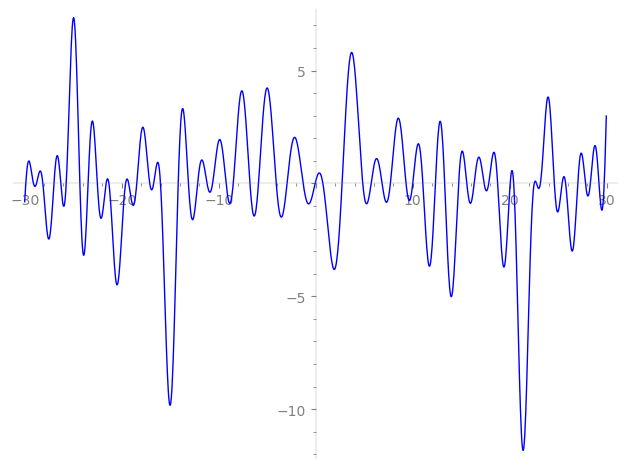| L(s) = 1 | + (−20.8 − 24.2i)2-s − 208.·3-s + (−153. + 1.01e3i)4-s + (4.35e3 + 5.06e3i)6-s − 1.75e4·7-s + (2.77e4 − 1.74e4i)8-s − 1.54e4·9-s − 2.65e5i·11-s + (3.20e4 − 2.11e5i)12-s + 6.47e5i·13-s + (3.66e5 + 4.25e5i)14-s + (−1.00e6 − 3.10e5i)16-s + 2.51e6i·17-s + (3.22e5 + 3.75e5i)18-s − 1.70e5i·19-s + ⋯ |
| L(s) = 1 | + (−0.652 − 0.758i)2-s − 0.859·3-s + (−0.149 + 0.988i)4-s + (0.560 + 0.651i)6-s − 1.04·7-s + (0.847 − 0.531i)8-s − 0.261·9-s − 1.65i·11-s + (0.128 − 0.849i)12-s + 1.74i·13-s + (0.681 + 0.792i)14-s + (−0.955 − 0.296i)16-s + 1.77i·17-s + (0.170 + 0.198i)18-s − 0.0688i·19-s + ⋯ |
Λ(s)=(=(100s/2ΓC(s)L(s)(−0.951+0.308i)Λ(11−s)
Λ(s)=(=(100s/2ΓC(s+5)L(s)(−0.951+0.308i)Λ(1−s)
| Degree: |
2 |
| Conductor: |
100
= 22⋅52
|
| Sign: |
−0.951+0.308i
|
| Analytic conductor: |
63.5357 |
| Root analytic conductor: |
7.97093 |
| Motivic weight: |
10 |
| Rational: |
no |
| Arithmetic: |
yes |
| Character: |
χ100(99,⋅)
|
| Primitive: |
yes
|
| Self-dual: |
no
|
| Analytic rank: |
0
|
| Selberg data: |
(2, 100, ( :5), −0.951+0.308i)
|
Particular Values
| L(211) |
≈ |
0.0156780−0.0992480i |
| L(21) |
≈ |
0.0156780−0.0992480i |
| L(6) |
|
not available |
| L(1) |
|
not available |
L(s)=p∏Fp(p−s)−1 | p | Fp(T) |
|---|
| bad | 2 | 1+(20.8+24.2i)T |
| 5 | 1 |
| good | 3 | 1+208.T+5.90e4T2 |
| 7 | 1+1.75e4T+2.82e8T2 |
| 11 | 1+2.65e5iT−2.59e10T2 |
| 13 | 1−6.47e5iT−1.37e11T2 |
| 17 | 1−2.51e6iT−2.01e12T2 |
| 19 | 1+1.70e5iT−6.13e12T2 |
| 23 | 1−5.21e6T+4.14e13T2 |
| 29 | 1+6.80e6T+4.20e14T2 |
| 31 | 1−2.47e7iT−8.19e14T2 |
| 37 | 1+9.23e6iT−4.80e15T2 |
| 41 | 1−1.44e8T+1.34e16T2 |
| 43 | 1+2.79e7T+2.16e16T2 |
| 47 | 1−1.10e8T+5.25e16T2 |
| 53 | 1−1.09e8iT−1.74e17T2 |
| 59 | 1−6.65e8iT−5.11e17T2 |
| 61 | 1+7.40e8T+7.13e17T2 |
| 67 | 1+4.17e7T+1.82e18T2 |
| 71 | 1+6.30e8iT−3.25e18T2 |
| 73 | 1−9.52e8iT−4.29e18T2 |
| 79 | 1−2.24e9iT−9.46e18T2 |
| 83 | 1+6.38e9T+1.55e19T2 |
| 89 | 1−1.29e9T+3.11e19T2 |
| 97 | 1+1.43e10iT−7.37e19T2 |
| show more | |
| show less | |
L(s)=p∏ j=1∏2(1−αj,pp−s)−1
Imaginary part of the first few zeros on the critical line
−11.20393652381320073086051892260, −10.63198947850785595388545363534, −9.237950029131086090790535954593, −8.502421450229253341532755520252, −6.77936038409013764240768671651, −5.90078477300172406405398140521, −4.06890723768001349674530244596, −2.95464723455804753763753152347, −1.29576765126569838835528415877, −0.05649516821811321837979156607,
0.73772941933681314947828211822, 2.71742817233799169414248547913, 4.84764446641227093314048212432, 5.71149636782158546563360200385, 6.84037908965263089548195792766, 7.69643353718041627380086483711, 9.310078406246055415323722417317, 10.00297335199419996230311534865, 11.04333774392127372021252435305, 12.33563905934230534923541070250

